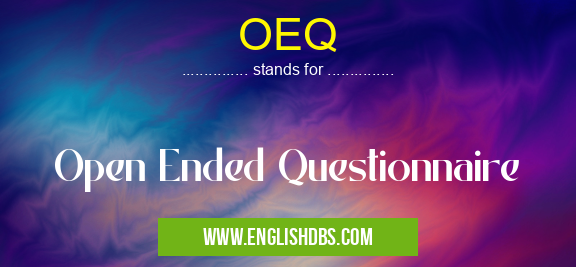What does OEQ mean in UNCLASSIFIED
OEQ stands for Open Ended Questionnaire. It is a research method that involves asking respondents open-ended questions, which are questions that cannot be answered with a simple "yes" or "no" response. Instead, respondents are given the opportunity to provide their own thoughts and opinions in their own words.

OEQ meaning in Unclassified in Miscellaneous
OEQ mostly used in an acronym Unclassified in Category Miscellaneous that means Open Ended Questionnaire
Shorthand: OEQ,
Full Form: Open Ended Questionnaire
For more information of "Open Ended Questionnaire", see the section below.
What is OEQ
OEQs are often used in qualitative research, where the goal is to gain an in-depth understanding of respondents' thoughts and feelings. They can be used to explore a wide range of topics, such as attitudes, beliefs, experiences, and motivations.
Advantages of OEQ
OEQs offer several advantages over closed-ended questions, such as:
- Provide richer data: OEQs allow respondents to provide more detailed and nuanced responses, which can lead to a deeper understanding of their perspectives.
- Uncover hidden insights: OEQs can help researchers uncover insights that may not be apparent from closed-ended questions.
- Flexible and adaptable: OEQs can be adapted to fit the specific needs of the research project.
Disadvantages of OEQ
However, OEQs also have some disadvantages, such as:
- Time-consuming to analyze: OEQs can be more time-consuming to analyze than closed-ended questions, as researchers need to read and interpret the responses.
- Difficult to compare responses: It can be challenging to compare the responses to OEQs across respondents, as the responses may vary in length and content.
- Prone to bias: OEQs can be more prone to bias than closed-ended questions, as the researcher's own biases may influence the way they interpret the responses.
Essential Questions and Answers on Open Ended Questionnaire in "MISCELLANEOUS»UNFILED"
What is an Open-Ended Questionnaire (OEQ)?
An OEQ is a survey method where respondents can provide their own answers to questions, rather than selecting from a list of predefined options. This allows for more in-depth and nuanced feedback.
What are the benefits of using an OEQ?
Using an OEQ offers several advantages, including:
- Unbiased responses as respondents are not limited by predefined options.
- Deeper insights into respondents' thoughts and experiences.
- Identification of trends and patterns in open-ended text responses.
What are some considerations when creating OEQs?
When designing OEQs, it is essential to:
- Define clear and concise questions that encourage thoughtful responses.
- Ensure questions are relevant to the research objectives.
- Keep the number of open-ended questions limited to allow ample time for responses.
How can OEQ responses be analyzed?
Analyzing OEQ responses typically involves:
- Coding responses into categories or themes.
- Using qualitative software or manual analysis to identify patterns and trends.
- Summarizing findings and drawing conclusions from the open-ended responses.
What are the limitations of OEQs?
OEQs may have certain limitations, such as:
- Time-consuming to administer and analyze due to the open-ended nature of responses.
- Potential for biases in coding and interpretation of responses.
- Difficulty in quantifying and comparing responses across a large number of participants.
Final Words: OEQs are a valuable research tool that can provide researchers with rich and in-depth insights into respondents' thoughts and feelings. However, it is important to be aware of the advantages and disadvantages of OEQs before using them in a research project.
